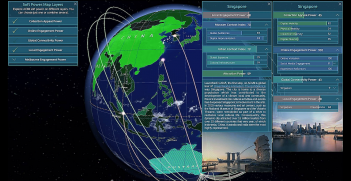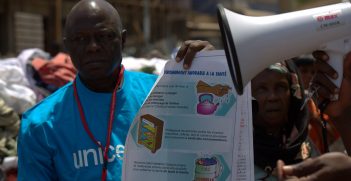Triple Threat: Floods, COVID-19, and Poverty and Inequality in Timor-Leste
In Timor-Leste, floods and landslides after cyclone Seroja, coupled with the COVID-19 pandemic, have created a dangerous dynamic. The next stage of the crisis will be hard to navigate as poverty-stricken Timorese struggle with fresh water, health services, and sufficient nutrition.
On 4 April, as the majority-Catholic nation of Timor-Leste would have normally been preparing for their Easter Sunday celebrations, a tropical low, ominously named cyclone Seroja was forming off the coast. The heavy rain started on 29 March, and over the next two days would cause significant rainfall and flooding in the capital Dili and surrounding municipalities. As of 12 April, all 13 municipalities have been affected, 46 deaths have been recorded (including 10 missing and presumed dead) and 13,554 people are displaced, and 25,022 houses have been affected. 46 percent of the affected are in the nation’s capital of Dili. According Deputy Prime Minister Jose Reid, these are the worst floods the country has experienced since the 1970s.
Over 4 and 5 April, the Comoro river leading from the sharp mountain rise to the nation’s capital of Dili quickly overflowed and impacted badly on the flood plains and low-elevation coastal areas. Aerial photos showed the city and sea as indistinguishable, blending into one. In the immediate aftermath, harrowing witness accounts of landslides told of a father trying desperately to dig out his daughters from under the mud, and many are still lost. Social media posts showed scenes of collapsing buildings and bridges, motorcyclists being swept away in the powerful flood waters, and a child carrying his stool and gas cooker overhead to safety.
While the floods left the presidential palace waterlogged and the roads in Dili inaccessible, the mountains also suffered. Heavy rain caused landslides and destroyed critical infrastructure such as roads, water and sanitation, and electricity. Places not far from the capital such as Laclubar and Remexio were completely cut off from essential services and food supplies and were forced to wait for humanitarian relief to arrive. Schools were halted because the students could not access their schools. Photos circulated on social media of people walking long distances with jerrycans to collect the pooling flood water.
In response to the recent crisis, the president of Timor-Leste has called for unity in action and declared a country-wide state of emergency. International support has come from Australia, China, the United States, Japan, and New Zealand. However, this crisis has been addressed by more localised efforts: volunteer groups raised funds online and delivered supplies, and local organisations such as Postu Haburas, Dili Delicious, Uma Lafatik, and Pro-Ema have set up kitchens and cooked for those in need.
Up until March this year, the government of Timor-Leste was a role-model for COVID-19 public health response throughout the region. Throughout 2020, Timor-Leste had no community transmission, and just 44 cases had been reported by the end of 2020. This was despite flooding in the capital during March 2020 which affected more than 1,500 households and caused significant infrastructure damage in Dili. During 2020 and into 2021, the national taskforce of government and non-government agencies worked together to respond to the social and economic impacts of the pandemic and implement a successful quarantine program.
The Easter 2021 floods occurred during a rise in COVID-19 cases that had prompted another lockdown. As a result of the flooding, the lockdown was lifted, and people were forced into evacuation centres. Research has assessed the likelihood of natural hazards coinciding with and influencing the COVID-19 pandemic, and unsurprisingly, a rise in cases was expected. Evacuation centres are crowded, social distancing is impossible, and hand sanitation, the key prevention mechanism, is difficult. The Ministry of Health, along with a consortium of NGOs, is coordinating the evacuation centres and providing support, but they are under pressure. The national medical storage facility was flooded, and many medical supplies were damaged and washed away, and the COVID-19 isolation facility had to be temporarily evacuated.
But despite all this, the government of Timor-Leste is making a herculean effort to tackle the current crisis. The Ministry of Health continues to conduct testing and contract tracing. The National Health Laboratory and other laboratory networks are capable of doing more than 1000 tests in a day, which was temporarily interrupted when the national health lab was flooded. While mud was being shovelled from the lab, 16 tests were successfully undertaken on Easter Sunday. And critically, refrigeration was able to be maintained. Testing time requires less than a 24-hour turn around.
Despite the challenges, the first vaccination program has managed to operate and timing of vaccine is absolutely critical. As part of the Australian aid response, the first lot of 24,000 AstraZeneca COVAX vaccines arrived on 5 April. The total number of doses allocated is 100,800. In Papua New Guinea, concerns have been raised about the risks associated with the AstraZeneca vaccine for its overwhelmingly young population. Timor-Leste has a similarly young population. 20 percent of the population is between the ages of 15 and 25 years. Putting aside the concerns about the risks, it is clear the devastation caused by the floods to the infrastructure around the capital and into the mountainous regions will impact on the speed of the roll-out.
The international assistance will certainly play a key role in helping Timor-Leste to manage the crisis, but taking a long-term and critical perspective on development is also needed. Timorese analyst Mica Barreto Soares in an article in 2019 called for serious reflection about where the US$17 billion from combined sources of donor funds and petroleum revenue has gone since 1999. In 2010, $1.5 million was spent on a sanitation and drainage masterplan for Dili, however these measures have been inadequate in protecting its people from flooding disasters. Timorese analysts and experts continue to advocate for better preparedness for disasters in Timor-Leste, the need to understand the interaction of multiple hazards, such as COVID-19, and better plan for settlement locations that are safe to inhabit and minimise inequality and the formations of slums.
The current ongoing crises are set against a background of ongoing poverty and inequality. In 2020, the Human Capital Index for Timor-Leste was 0.45, ten points below that of the regional average of East Asia and the Pacific. In the two rounds of the Timor-Leste Living Standards survey, the national poverty line, which represents the average cost of meeting basic needs, grew by 84.5 percent, from $25.14 per person per month in 2007 to $46.37 per person per month, and it is predicted to have increased since then. While the number of those living in poverty has fallen since the previous decade, growing inequality based on geography, gender, and age is a concern, and while social protection mechanisms are welcome during a crisis, they are not adequate to lift people out of poverty.
In its approach to human development, Timor-Leste’s basic services such as urban planning, water, sanitation, health services, and sufficient nutrition for children and pregnant mothers are left wanting. As pointed out by many Timorese analysts, while the country has invested heavily in oil-related activities, it has yet to see comparable investment in education, or sustainable work industries for its young. The budget for agriculture has remained one of the most poorly funded areas of the national budget for the past 20 years, despite most of its population being rurally-based and agriculture-dependent. Taking a long-term approach to understanding how climate change affects the poorest and most vulnerable should be a key part of development. The latest double crisis of the floods and the COVID-19 pandemic, for which the government of Timor-Leste must be commended in its response, also represents a significant opportunity for Timor-Leste to focus on development for the most vulnerable and follow through with what many Timorese have been calling for: putting people at the centre of development.
Angie Bexley is a senior research fellow at the Poverty and Inequality Research Centre, Crawford School of Public Policy, The Australian National University.
The author would like to thank East-Timorese analyst Guteriano Neves for his contribution.
This article is published under a Creative Commons License and may be republished with attribution.





